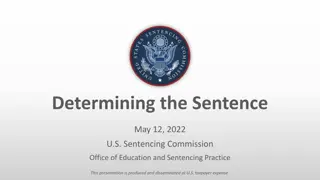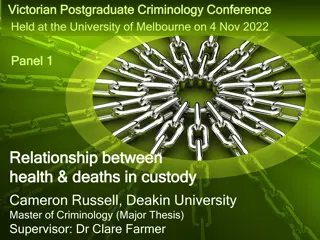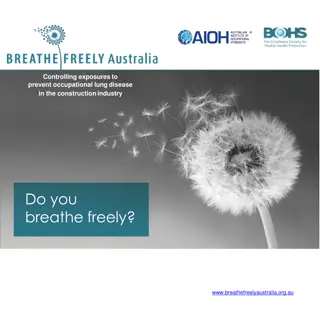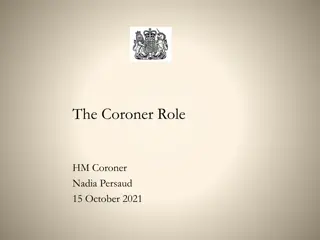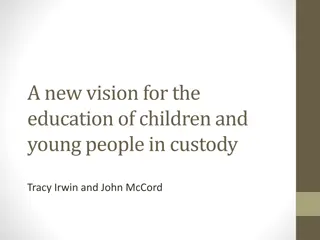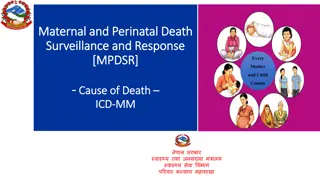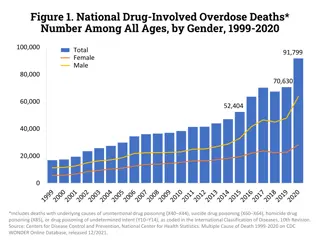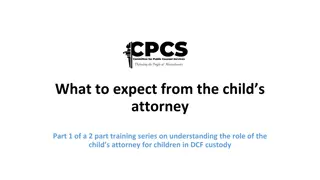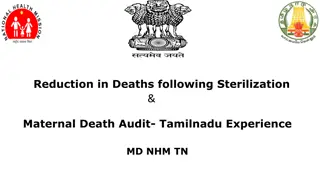Relationship Between Health and Deaths in Custody in Australia
In Australia, the relationship between prisoner health and deaths in custody is a critical issue. Indigenous inmates are disproportionately affected, with higher death rates compared to non-Indigenous inmates. Addressing prisoner health may offer a potential solution to reducing custodial deaths. The statistics highlight the stark disparities in incarceration rates and death rates between Indigenous and non-Indigenous populations.
Download Presentation

Please find below an Image/Link to download the presentation.
The content on the website is provided AS IS for your information and personal use only. It may not be sold, licensed, or shared on other websites without obtaining consent from the author. Download presentation by click this link. If you encounter any issues during the download, it is possible that the publisher has removed the file from their server.
E N D
Presentation Transcript
35 35th th Annual ANZSOC Conference Annual ANZSOC Conference Held in Melbourne on 06-08 Dec 2023 Paper 8 Paper 8 Session 7 Session 7 Relationship between Relationship between health & deaths in custody health & deaths in custody Cameron Russell, Deakin University Master of Criminology (Major Thesis) completed 2022 Supervisor: Dr Clare Farmer
Acknowledgement of Country I acknowledge and pay my respects to past, present and emerging Elders and Custodians of the land on which we meet, the Wurundjeri Woi Wurrung and Bunurong peoples of the Kulin Nation. These stolen lands have never been ceded. Content advice Aboriginal and Torres Strait Islander people are respectfully advised that this thesis contains references to people who have passed away.
The relationship between health & deaths in custody in Australia Overview Problems: Extremely poor prisoner health Reduction in custodial deaths has reached plateau One possible solution: Improving prisoner health may reduce deaths
Background Death rates in prison (2020-21): Indigenous inmates died at a rate of 0.09 per 100 prisoners Non-Indigenous inmates died at a rate of 0.18 per 100 prisoners (AIC 2021b:Deaths in prison custody:Table B:1).
Indigenous incarceration Indigenous people comprise just 3.8% of the Australian population but constitute 32% of the prison population! (ABS 2022) Australian incarceration rate: 206/100k Indigenous incarceration rate: 2470/100k Plus the Indigenous death rate in police custody is 7.5 times higher!
Deaths in prison custody since 1990 (rate per 100 relevant prisoners) 3.5 3 SOURCES: AIC 2021c:Deaths in prison custody:Tables D5,D6,D10. 2.5 2 1.5 1 0.5 0 1990 1991 1992 1993 1994 1995 1996 1997 1998 1999 2000 2001 2002 2003 2004 2005 2006 2007 2008 2009 2010 2011 2012 2013 2014 2015 2016 2017 2018 2019 2020 2021 Total Rate per 100 relevant inmates Indig. Rate per 100 relevant inmates Non-Indig. Rate per 100 relevant inmates Male Rate per 100 relevant inmates Female Rate per 100 relevant inmates <25 years Rate per 100 relevant inmates 25-39 years Rate per 100 relevant inmates 40-54 years Rate per 100 relevant inmates 55+ years Rate per 100 relevant inmates
Hypothesis Narrow hypothesis (examined in this paper): Poor prisoner health and healthcare in Australia are contributors to deaths in custody and health improvements are likely to reduce deaths in custody Broad hypothesis (not examined in paper): Prisoner health improvements are related to and likely to reduce recidivism, injury and death rates for those held in custody
Standard of healthcare required for Australian (and Victorian) prisoners Minimum: Prisoners should receive a comparable standard of healthcare to that received by the general community Standards for health services in Australian prisons Rules 24,25,27 of the UN Nelson Mandela Rules Principles 4.1.4,4.1.5,4.1.8 of the Guiding Principles for Corrections in Australia [ETC] States and Territories are given leeway to develop their own laws and standards (CSAC 2018) In Victoria: Correctional Management Standards for Men s Prisons in Vic (2014) Standards for the Management of Women Prisoners in Vic (2014) Justice Health Quality Framework (2014) Justice Health Performance Monitoring Program (for continuous improvement) (2014) Commissioner s Requirements (2021) [ETC]
Further prisoner health rights: Right to access reasonable medical care and treatment necessary for the preservation of health - Section 47(1)(f) of the Corrections Act 1986 (Vic) Right for prisoners who are intellectually disabled or mentally ill to have reasonable access within the prison or, with the Governor's approval outside a prison - Section 47(1)(g) Right to reasonable dental treatment necessary for the preservation of health - Section 47(1)(h) A number of International laws and treaties
Rationale Many studies have examined the strong correlation between (disadvantage/ poor health) and (incarceration/ recidivism/ prison injury) (e.g. Baldry et al. 2018; Cunneen and Luke 2007; Vinson 2007) Links between prisoner health and deaths in custody have been the subject of much less analysis
Brief literature review (1) Venters H (2019) Life and Death in Rikers Island, Johns Hopkins University Press, Baltimore: Jail-attributable deaths include suicides, homicides & other deaths where systemic or individual errors made a substantial contribution to the deaths Should be tracked Typically 10-20% of all deaths in custody, but can spike to nearly 50% at times
Brief literature review (2) Applying Venters to Australia: This thesis concerned with custody- attributable causes of death Australia does not track (but should) Custody-attributable deaths will generally result if the custodians fail to: protect the incarcerated from themselves protect the incarcerated from each other provide the expected level of care
Brief literature review (3) Venters draws a link between prisoner health and deaths in custody (2019:1): The health risks that jail or prison brings to bear on the incarcerated such as violence, blocked access to care, and solitary confinement disproportionately impact those with behavioral health problems and people of color. I ve come to believe that accounting for the health risks of the jail system is one of our [prison medical staff s] core responsibilities.
Brief literature review (4) Venters (2019:14): The most serious health risk of incarceration is death [H]undreds more men and women die every year as a result of something that happens to them in jail or prison. The cause is usually portrayed as individual negligence of health or security staff, but in truth, these examples reveal a constant risk of incarceration, a feature of the system we have designed and grown accustomed to.
Brief literature review (5) Girard R (1973) Violence, the sacred, and things hidden: A discussion with Ren Girard at Esprit (McKenna AJ trans), Breakthroughs in mimetic theory (Johnsen WA ed), Michigan State University Press, East Lansing: Violence is embedded within institutions Violence must remain hidden to be effective More effective to expose than react to engrained institutional violence
Brief literature review (6) Gorringe TJ (2002) The prisoner as scapegoat: Some skeptical remarks on present penal policy , in O Connor TP and Pallone NJ (eds) (2002) Religion, the community, and the rehabilitation of criminal offenders, Haworth Press, New York. Girard R (1986) The Scapegoat (Freccero Y trans), Baltimore, John Hopkins University Press: To survive, societies may elect to find scapegoats to receive all the pent-up frustration and rage of society, then to exclude them (outside the community)
Brief literature review (7) Grimsrud T and Zehr H (2002) Rethinking God, justice, and treatment of offenders , in O Connor TP and Pallone NJ (eds) (2002) Religion, the community, and the rehabilitation of criminal offenders, Haworth Press, New York: Incarceration = intentional application of pain and coercion = a form of violence Punishment by the state is morally problematic as it involves the state doing things normally considered morally unacceptable [This] has given rise to a huge variety of justifications for delivering such pain, the main one being imprisonment
Brief literature review (8) Databases of the AIC (on Australian deaths in custody) and The Guardian Newspaper Australia (on Indigenous deaths in custody). The Guardian suggested that their data raised issues of systemic racism. Prior to Indigenous deaths in custody: Police, prisons & hospitals were twice as likely to fail to follow their own procedures Medical care required but not given in over 38% of the Indigenous deaths Failure to follow all procedures in over 41% of the Indigenous deaths Indigenous people 3 times more likely to receive inadequate medical care
Brief literature review (9) The literature questions the current approach to prisoner healthcare standards in a number of ways: 1. Justice health services continue to treat comparable care as merely a goal or aspiration. They have been admonished by ombudsmen, inspectors & coroners for providing inadequate healthcare by community standards
Brief literature review (10) 2. AMA: There is a strong association between imprisonment and poor health. As a group, prisoners and detainees have far greater health needs than the general population Equal treatment will therefore maintain the health gap and entrench disadvantage. What is needed is equitable access to the healthcare needed and equitable health outcomes.
Brief literature review (11) 3. Talking in terms of prisoners receiving comparable healthcare to the general population/community subtly excludes prisoners from the community. A more enlightened & inclusive approach would be to treat prisoners as members of the community and as such deserving the level of healthcare needed (Venters 2019:122). Related: Medicare & Pharmaceutical Benefits Scheme-funded services for prisoners meeting the eligibility criteria
Research scope Thesis scope: Prison and police custody Focus: Sentenced & remanded prisoners, but also people detained in police holding cells, people evading police/prison custody & people in/evading youth detention Geographic scope: All Australian States and Territories Temporal scope: The decade from 01 July 2011 to 30 June 2021
Research sample In each State/Territory, up to 10 Indigenous deaths plus the same number of non-Indigenous deaths Overall, 115 deaths in custody: 57 Indigenous and 58 non-Indigenous 105 males and 10 females Detailed data is available online at: www.aprj.com.au/data.html
Content analysis A codebook used for extracting data from 115 coronial reports: 9 key identifiers (dates of death & birth; first & last names; gender; Indigenous status; age at death; place of death; location of death: prison, holding cell, pursuit, arrest) 5 key health data (whether adequate care provided & various defined levels for health, drugs & alcohol) 3 background info (coronial links, media links, background to death) 2 coroner findings (recommendations/comments)
State & Territory findings According to AIHW statistics for 15 major health indicators: ACT = 2ND WA= 2ND TAS = WORST WORST BEST NT = BEST HEALTHCARE HEALTHCARE HEALTHCARE HEALTHCARE NSW had a cluster of 6 suicides, all non-Indigenous In NSW, 80% of Indigenous prisoners received inadequate treatment whereas no non-Indigenous prisoners received inadequate treatment. The magnitude of this difference raises the prospect of systemic racism. An analysis of the deaths reveals systemic failures and at least a certain passivity towards the Indigenous inmates
Australian findings Health level 2.6%of sample had good or very good health prior to their death 13% had an average or unknown level of health 67%had very poor health and another 17.4% had poor health (total 84.4%) Very poor health : Indigenous prisoners (68.4%) cf. non- Indigenous prisoners (65.5%) Male prisoners (67.6%) cf. female prisoners (60%). Aboriginal males with very poor health (70.8%)
Australian findings Age at death Indigenous people 37.8 Non-Indigenous people 52.3 Ave. age at death Mean age at death of the outside Aust community Deaths at age 29 & below Deaths at age 60 & above 58 for males, 63 for females 79 for males, 85 for females 32.1% 10.7% 8.9% 37.5%
Australian findings Disproportionate responses and outcomes Indigenous people 3 times more likely to die in holding cells (5.3% cf. 1.7%), often with inadequate police observation/use of force Indigenous people 4 times more likely to die in cases of police restraint or use of force, typically with positional asphyxia Indigenous people over 4 times more likely to die in police pursuits (21.1% cf. 5.2%) Preventable deaths: Need cameras in police vans, more Indigenous health workers, better transport/RTA services in remote areas
Australian findings Mental health of people shot by police Systemic problem: 41% diagnosed with mental illness, PLUS another 21% undiagnosed but thought to be mentally ill PLUS the proportion of the unrecorded 26% who had mental illness Excluding the unrecorded figures, 82.9% of people shot by police had diagnosed or undiagnosed mental illness 65.6% of people shooting themselves have diagnosed or undiagnosed mental illness CAHOOTS: Health professionals and social workers deal with incidents involving mental health issues (17% of police calls). Only 0.6% of incidents require police backup (Abrams 2020)
Conclusion (1) Strong correlation between prisoner health and deaths in custody: Mental health issues can lead to self-harm, suicides, fatal restraint and police shootings (more places in forensic hospitals needed jail fails) Upstream public health issues (Viggiani 2006:307) that spiral down into prison (such as disadvantage in work, education, accommodation and healthy recreation in the poorer suburbs that feed prisons)
Conclusion (2) Each case is inordinately complex and requires deep and sustained attention on the part of a broad range of stakeholders Failure to provide adequate healthcare has a direct impact on deaths Improving prisoner health is a promising way to reduce deaths in custody (as well as injuries in custody, recidivism, and generational disadvantage & incarceration) Incarceration is itself a social determinant of health (Viggiani 2006:307-310, 313)
Thank you for your attention Cameron Russell Study data: aprj.com.au/data.html










